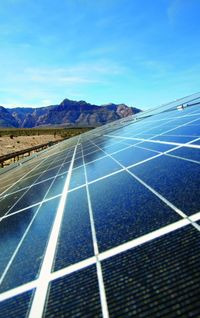Offshore wind energy has become a crucial component in the global push for clean energy and decarbonisation with over 75GW capacity installed around the world by the end of 2023. Offshore wind projects have certain advantages over their onshore counterparts such as higher adequacy, efficiency and reliability, lower storage requirement, no land acquisition related issues, etc. By Ramanuj Kumar, partner and co-head projects, energy and energy transition, and Aiswarja Mohanty, partner, energy and infrastructure, Cyril Amarchand Mangaldas
India, with its long coastline of over 7,500km, has significant offshore wind potential, particularly in states like Gujarat, Tamil Nadu and Andhra Pradesh. By various estimates, only Gujarat and Tamil Nadu coasts have the potential to accommodate roughly 70GW of offshore wind projects. With India’s ambitious renewable energy capacity target, 500GW by 2030, offshore wind projects are expected to play a critical role in achieving these targets. Recognising the importance of offshore wind generation, the government of India has adopted several policy initiatives to provide a conducive environment for growth and development of this sector.
In this article, we review India’s legal and policy framework to promote offshore wind projects and suggest some improvements to make these projects attractive for investment.
The Indian legal regime
India's policy framework for offshore wind energy projects is reflective of the government's ambitions to scale offshore wind industry and facilitate private investment. That, along with the tested legal regime for onshore wind, is expected to facilitate large-scale development while addressing challenges such as environmental protection, grid integration and attracting investment. It has the following key components:
* Electricity Act – Electricity is a concurrent subject under the Seventh Schedule of India’s Constitution, which means both the federal government and state governments are empowered to regulate and administer electricity generation, transmission and distribution.
The Electricity Act, 2003 was enacted by parliament to consolidate laws relating to generation, transmission, distribution, trading and use of electricity, rationalisation of electricity tariff, provision of non-discriminatory open access in transmission and promotion of renewable energy through regulatory interventions such as specifying renewable energy purchase obligations and facilitating grid connectivity of renewable energy projects. The Ministry of New and Renewable Energy (MNRE) is the highest federal authority that governs renewable energy generation in India.
* National Offshore Wind Energy Policy (2015) – The NOWE Policy formulated by the MNRE, lays the foundation for offshore wind energy development. It sets out the objectives of the policy, lays down a broad framework for the development of offshore wind energy sector, roles of various stakeholders including the National Institute of Wind Energy (NIWE), which is designated as the nodal agency, and outlines various development models.
Two key takeaways from the NOWE Policy are: (i) NIWE being tasked with the responsibility to obtain in-principle clearances/permits from identified ministries/ departments before notification of the offshore wind energy blocks for bidding; and (ii) setting out the requirement of international competitive bidding for award of offshore wind blocks.
Upon conclusion of the auction process, NIWE is authorised to enter into a contract with the successful bidder and collect lease fee during survey, construction and operational phases. The NOWE Policy lists out the permits required by the project sponsor/developer and NIWE is required to facilitate procurement of such permits by the project developers.
Given the sensitivity of offshore operations in India and requirement to obtain a variety of permits from various ministries/departments, NIWE is expected to play an important role in facilitating expeditious grant of permits for the offshore wind project development and operation.
Grid integration and power evacuation – Offshore wind farms must integrate with the national grid while meeting the Indian Electricity Grid Code standards for system stability.
The Viability Gap Funding scheme for offshore wind projects (VGF scheme), administered by the MNRE, and the tender documents (issued in the recent past) specify that the interconnection/metering point for offshore wind projects will be an offshore pooling substation constructed as part of the inter-state grid network by the Central Transmission Utility (CTU).
Evacuation of power to such interconnection point shall be the responsibility of the project developer.
Figure 11 sets out the scope of work of the project developer relating to the evacuation arrangements. With the CTU being given the responsibility to construct and maintain an offshore pooling substation, the offshore wind project developers are largely derisked in respect of the evacuation arrangements.
That said, project developers will need to coordinate with the CTU for connectivity of the project with the offshore pooling substation and any capacity augmentation required to the national grid.
![]()
Environmental and coastal regulations
Offshore wind projects in India, as in other jurisdictions, are subject to a series of environmental and coastal regulations, which are administered by several regulatory authorities. The project developer must obtain an environmental clearance from the Ministry of Environment, Forest and Climate Change, and a separate clearance under the Coastal Regulation Zone Notification, 2011 which regulates construction and development along India’s coastline.
These permits are critical for the project and involve submission of a detailed environmental impact assessment report. Additionally, offshore wind projects are required to comply with the Fisheries Act, 1897 and the Indian Wildlife Protection Act, 1972 to protect marine life and fisheries.
* Other key approvals – Since offshore wind projects are developed in the maritime domain, they must also comply with regulations set by the Ministry of Shipping and other maritime authorities. These include compliance with the Merchant Shipping Act, 1958 governing the safety of navigation and shipping in the maritime zones of India.
Project development in offshore areas also assume significance from the national security perspective and accordingly, project developers are required to obtain permits from the Ministry of Defence and Ministry of External Affairs and ensure compliance with various inspection and notification requirements specified by these ministries.
Additionally, project developers are also expected to consider potential requirement of obtaining clearances from the Ministry of Petroleum and Natural Gas, Department of Telecommunication and Ministry of Mines if the offshore wind block fall within or near the blocks/areas earmarked for hydrocarbon or mineral exploration and development.
Key policy incentives
The government has announced several incentives to boost the development of offshore wind projects. These include: (i) Viability Gap Funding, which helps bridge the gap between project costs and revenues, thereby making offshore wind projects more attractive to investors, (ii) tax incentives: such as tax holidays for 10 years, accelerated depreciation benefits, which enhance the financial viability of these projects; (iii) concessional customs duty benefits for the import of certain critical equipment and materials, which lowers initial capital expenditure, and (iv) waiver of interstate transmission system charges and additional surcharge for projects commissioned until December 31 2032.
These fiscal and tax incentives, combined with support for grid integration and environmental clearance facilitation, are designed to stimulate both domestic and international investment in India’s offshore wind sector.
Project development models
On September 26 2023, the MNRE released a strategy paper for the establishment of offshore wind projects wherein it outlined three potential models:
i) Model A, the VGF model – This entails auction of demarcated offshore wind zones for which MNRE/NIWE has already carried out detailed surveys/studies. Central financial assistance in the form of VGF will be made available to achieve a predetermined tariff for supply of energy.
ii) Model B, non-VGF but exclusivity over seabed during study/survey – This model proposes award of pre-identified zones/sites to potential developers on lease through a single stage two envelope bidding. The developer will undertake project development without any financial assistance and the power generated from such projects can be used either for captive consumption or sold to any entity through bilateral power purchase agreement or through the power exchanges.
The rationale under this model is if the project developer can find buyers (other than the distribution utilities which supply power to retail consumers) at a negotiated tariff, no financial support from the government would be necessary for such projects. While the strategy paper notes the government may call for bids for procurement of power for distribution utilities on the basis of tariff after two years under this model, there is no hard obligation to procure up power under this model.
iii) Model C, non-VGF no exclusivity – Under this model, a developer may identify any offshore wind site within the exclusive economic zone of India – other than sites demarcated under Model A and Model B – and carry out studies and surveys. The MNRE or a nominated agency will invite bids for project development/allocation of seabed with the bid parameter being lease fee, tariff based competitive bidding or any other transparent bidding mechanism.
The developer which has carried out surveys/studies will be provided a first right of refusal. However, no financial assistance will be applicable for projects under this model. It remains to be seen whether earning a right of first refusal – for tariff or revenue sharing discovered through a bid process – will be enough incentive for potential project developers to opt for this model.
VGF scheme
The aforesaid three models mooted by the MNRE notwithstanding, the most significant government initiative for offshore wind projects is the VGF Scheme with a total outlay of approximately Rs468.5bn for installation of 1000MW offshore wind capacity off the coast of Gujarat and Tamil Nadu and Rs6bn for upgradation of two ports to meet the logistics requirements.
The VGF Scheme will be implemented through a transparent selection process undertaken by Solar Energy Corporation of India Limited (SECI), which is a federal government-owned entity and has played a key role in rapid expansion of solar and wind generation projects in the country. Some of the key elements of the VGF Scheme are as follows in Table 1.
![]()
Recent invitations to bid
SECI has recently invited bids for development of 4,000MW offshore wind capacity in the Gulf of Mannar, off the coast of Tamil Nadu and 500MW offshore wind capacity in the Gulf of Khambhat, off the coast of Gujarat.
* Gujarat project2 – Capacities under this project fall under the VGF Scheme and will be developed on a build-own-operate basis over 202 square kilometres, with a 25-year power purchase agreement and VGF capped at Rs81m per MW. Power will be procured at a fixed tariff of Rs4.5/kWh by SECI and supplied to the distribution utilities of Gujarat.
* Tamil Nadu project3 – Capacities under this project fall under Model B with the bid parameter being the quoted seabed allocation fee in respect of each block which is over and above the lease rental of Rs100,000/km2 per year. Under the RfS3, it is proposed to lease seabed areas for 4000MW capacity. The developer will undertake survey and development activities and design, build, finance, commission, operate, maintain and decommission the projects.
The energy generated from these offshore projects may be sold to captive users or sold to third parties through mutually negotiated tariff or on the power exchanges or by participating in bids for public procurement (though there is no obligation on the government to buy power generated from projects set up under this model).
Key challenges
Large-scale development of offshore wind projects in India face significant challenges, the primary one being the high cost involved in setting up and maintaining such projects. This is due to larger turbines, specialised cables which can withstand sea pressure, higher logistics cost, construction and O&M costs, etc.
Without financial support from the government, the tariff for offshore wind projects would be too costly to absorb for Indian consumers. Even with the VGF scheme, the offered tariff of Rs4.5/kWh is approximately 30% higher than the average tariff for onshore wind projects. Therefore, viability of tariff from offshore wind projects remains a key concern for the Indian policymakers and potential project developers and off-takers alike. A pilot capacity of 1GW at Rs4/kWh may be tied up with the distribution utilities but a larger capacity absorption will require levelised tariff to be comparable to other renewable energy sources.
Other significant challenges will be the logistics and port infrastructure. Offshore wind projects require a designated port facility, including an onshore office and storage warehouse to act as the hub for all operational and maintenance activities required during the construction and operational phase of the project.
Setting up required port and logistics capacities would require additional financial support from the government at least until a healthy pipeline of offshore wind capacity develops for award. The success for offshore wind in India will be largely contingent on how quickly India is able to develop an ecosystem and supply chain for the same.
The way forward
Since the offshore wind industry is at a nascent stage, VGF Model appears to be the most attractive model for the establishment of projects. The proposed alternatives under Models B and C appear premature and potentially ill-suited for a sector where there is no existing supply chain, inadequate port and logistics infrastructure and limited domestic technological and manufacturing capacity.
Offshore wind projects are capital intensive projects and would require certainty of long-term cashflows to become bankable. While India has witnessed a boom in corporate PPAs with falling renewable energy levelised tariffs, it is doubtful whether project developers can tie up a 25-year PPA with corporate customers for offshore wind projects where levelised tariff for initial set of projects may fall in the range of Rs6–Rs7/kWh.
The government should announce a pipeline of at least 6GW–10GW projects that will be eligible for VGF support. This will enable development of back-end infrastructure, and local expertise in logistics management, construction, operation and maintenance of these projects. Placing faith in Models B and C may be premature and misplaced, at least until the levelised cost of electricity from offshore wind projects is brought down to Rs3.5–Rs4/kWh without any subsidies/financial incentives. The other models can work only after certain scale and size is achieved for the offshore wind sector.
In addition, NIWE should assume greater responsibility for obtaining permits and coordinating with government authorities. Given that any operations in the offshore region will continue to be heavily regulated and monitored, it is imperative that the government streamline the permitting process to provide confidence to the private sector (and foreign investors) that they will not face undue regulatory hurdles.
This will reduce development risks, prevent cost and time overruns, and enable greater participation. The government should also recognise other challenges in the supply chain model for offshore projects and address the same to provide overall impetus to offshore wind development.
One such step could be to designate one port each on Gujarat and Tamil Nadu coasts to support offshore wind projects and provide financial incentives to these ports to develop infrastructure for handling wind generation equipment. India’s renewable energy ambitions and decarbonisation targets demand a faster and sustainable adoption of offshore wind generation projects with the federal government playing a key role in ensuring its success.
Footnotes
1 - Sourced from tender document: https://www.seci.co.in/Upload/Tender/SECI000188-1526005-RfSfor500MWOffshoreWind-Gujarat-finalupload.pdf)
2 - https://www.seci.co.in/Upload/Tender/SECI000188-1526005-RfSfor500MWOffshoreWind-Gujarat-finalupload.pdf
3 - SECI000137-5687983-RfSforallocationofSeabedLeaseRights-4000MWOffshoreWindProject.pdf
To see the digital version of this report, please click here.
To purchase printed copies or a PDF of this report, please email leonie.welss@lseg.com















